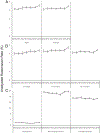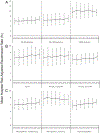Trends in Pediatric Hospitalizations and Readmissions: 2010-2016
- PMID: 30696756
- PMCID: PMC6764425
- DOI: 10.1542/peds.2018-1958
Trends in Pediatric Hospitalizations and Readmissions: 2010-2016
Abstract
Background: Health reform and policy initiatives over the last 2 decades have led to significant changes in pediatric clinical practice. However, little is known about recent trends in pediatric hospitalizations and readmissions at a national level.
Methods: Data from the 2010-2016 Healthcare Cost and Utilization Project Nationwide Readmissions Database and National Inpatient Sample were analyzed to characterize patient-level and hospital-level trends in annual pediatric (ages 1-17 years) admissions and 30-day readmissions. Poisson regression was used to evaluate trends in pediatric readmissions over time.
Results: From 2010 to 2016, the total number of index admissions decreased by 21.3%, but the percentage of admissions for children with complex chronic conditions increased by 5.7%. Unadjusted pediatric 30-day readmission rates increased over time from 6.26% in 2010 to 7.02% in 2016 with a corresponding increase in numbers of admissions for patients with complex chronic conditions. When stratified by complex or chronic conditions, readmission rates declined or remained stable across patient subgroups. Mean risk-adjusted hospital readmission rates increased over time overall (6.46% in 2010 to 7.14% in 2016) and in most hospital subgroups but decreased over time in metropolitan teaching hospitals.
Conclusions: Pediatric admissions declined from 2010 to 2016 as 30-day readmission rates increased. The increase in readmission rates was associated with greater numbers of admissions for children with chronic conditions. Hospitals serving pediatric patients need to account for the rising complexity of pediatric admissions and develop strategies for reducing readmissions in this high-risk population.
Copyright © 2019 by the American Academy of Pediatrics.
Conflict of interest statement
POTENTIAL CONFLICT OF INTEREST: The authors have indicated they have no potential conflicts of interest to disclose.
Figures


References
-
- Berdahl TA, Friedman BS, McCormick MC, Simpson L. Annual report on health care for children and youth in the United States: trends in racial/ethnic, income, and insurance disparities over time, 2002–2009. Acad Pediatr. 2013;13(3):191–203 - PubMed
-
- Urban Institute. Uninsurance among children, 1997–2015: long-term trends and recent patterns. 2016. Available at: https://www.urban.org/research/publication/uninsurance-among-children-19.... Accessed January 22, 2018
-
- Homer CJ, Patel KK. Accountable care organizations in pediatrics: irrelevant or a game changer for children? JAMA Pediatr. 2013;167(6):507–508 - PubMed
-
- Kelleher KJ, Cooper J, Deans K, et al. Cost saving and quality of care in a pediatric accountable care organization. Pediatrics. 2015; 135(3). Available at: www.pediatrics.org/cgi/content/full/135/3/e582 - PubMed
Publication types
MeSH terms
Grants and funding
LinkOut - more resources
Full Text Sources
Medical

